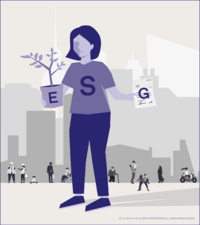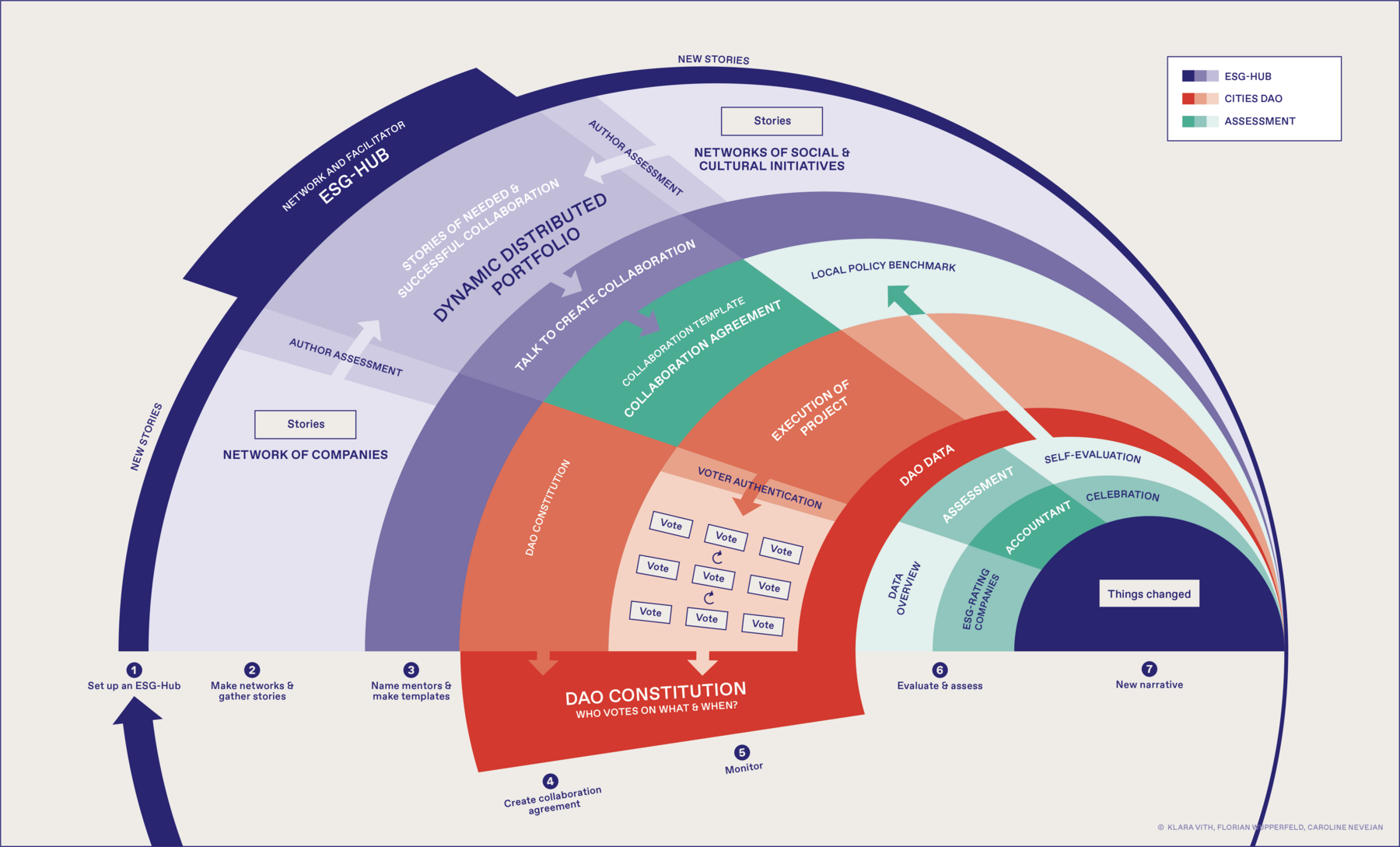How to start your CitiesDAO
Step 1: Set up an ESG Hub

Step 2: Gathering stories
Every social of cultural initiative and every company have a story which explains the motivations and objectives to be achieved by the local communities. Companies and organizations their stories on the citiesDAO website explaining their ambitions and needs through text, pictures, and videos. The participation on the platform begins with an assessment by external rating agencies, ensuring the credibility and socio-ecological scores of newly joined organizations. In the case of the Masterplan Zuidoost Maex assess the social and cultural initiatives, GSIS checks the performance of the companies.
Step 3: Name Mentors and make templates
In the ESG Hub, different mentors match and coach the new collaborations. Collaborators now meet in real life. Because the ESG Hub orchestrates the networks of companies and networks of social and cultural initiatives, it is capable of assisting in a precise and granular way in the matching between companies and social and cultural initiatives. Mentors moderate, by checking stories’ adherence to city-specific urban development objectives. We call it a ‘local policy benchmark’ because cities want to evaluate how initiatives would contribute to the overall urban development vision. Mentors help to translate the stories into templates in which who, doing what, where, and when and for how long and also input, output, outcome and impact are formulated. The making of templates helps to steward collaborations between civic, public, and private sectors.
Step 4: Collaboration agreement.
Through a matchmaking process facilitated by an ESG Hub, organizations can find common ground and forge collaboration agreements aimed at achieving ESG goals. Agreements consist of three elements: local policy benchmark, DAO constitution, and a collaboration template:
- Local policy benchmark: In the case of citiesDAO Demo in Amsterdam, the local policy benchmark is based on Masterplan Zuidoost 2035, a comprehensive policy document setting ambitions for the district’s socio-cultural development. Masterplan Zuidoost has five ambitions to be achieved at 2035, each with set of clearly defined and measurable indicators. In citiesDAO Demo, we focus on three ambitions, namely “Youth”, “Safety”, and “Liveability”.
- DAO Constitution: In the terminology of DAO, a constitution is a set of rules, protocols, and governance principles that dictate how the DAO operates. This digital constitution outlines a project's purpose, decision-making processes, voting mechanisms, membership criteria, and other essential parameters.
- Collaboration template: The collaboration agreement is a document that answers such questions as ‘What are the inputs, output, outcome, and impact of the collaboration?’, ‘Who are the collaborators?’ , ‘What is the geographical area for collaboration?’. Templates are based on scientific frameworks YUTPA and the Theory of Change. YUTPA is an acronym for “being with You in Unity of Time, Place and Action”, a framework developed by prof. dr. Caroline Nevejan for designing trust.
- Authenticate identities: Not in this demo, but later all collaborators of a newly created collaboration agreement should authenticate their identities. Authentication is required to ensure that a collaborator and not anyone else log in the system. In this Demo, the only authentication method is email. In the real fully-fledged technology, it will be possible to register with a phone number or DigiD, to ensure that even citizens who are not tech-savvy can easily register and participate. When a participants registers, the citiesDAO platform creates a blockchain wallet to ensure a secure voting.
Step 5: Monitoring
All collaborators constitute a ‘community of voters’ that will monitor the progress of their projects. Monitoring happens regularly and within a specific time frame (for instance once in 3 months, within 3 days). Collaborators perform monitoring via their mobile phones (for instance, a special app, or in a browser). They should answer a couple of simple questions, for instance, “How do you feel about the project's progress? (good/okay/bad”), and “Did the project move further? (yes / a bit /no)”. Apart from questions, they can attach photos that demonstrate the progress. As the project is complete, external partners can evaluate its results with help of data collection independently from the project collaborators.
Step 6 Evaluation and assessment
The project finishes with a coming together with all participants and evaluate what happened with special evaluators of the ESG Hub present. The gathered voting data, the gathered picture and small notes and the assessment together create the report or the accountants. By the external evaluation, we ensure the trustworthiness of the data for an ESG report. The accountant can check the monitoring system directly on the blockchain. The report tells the story of the collaboration and forms in itself a new narrative upon which new collaborations can be built.
Step 7: Narrative
When the collaboration is complete, the “win-win-win” is achieved: the city benefits from sustainable solutions, socio-cultural initiatives receive much-needed support, and private companies earn the ESG certificate, enhancing their market position and credibility. All the data points collected during collaboration, such as photos of monitoring and external evaluation, compile a narrative of a complete collaboration.
